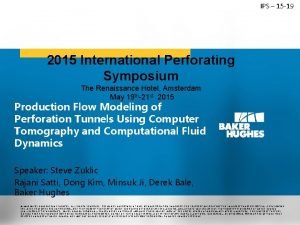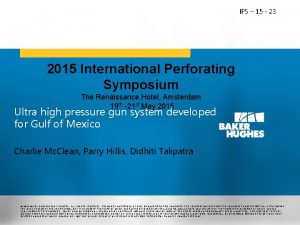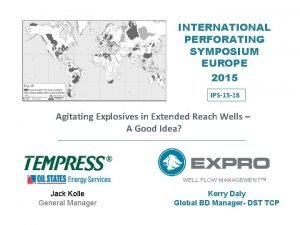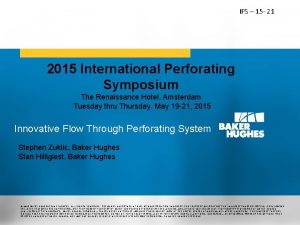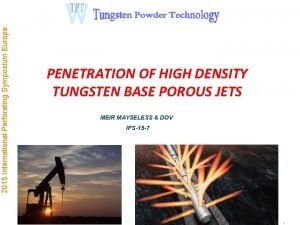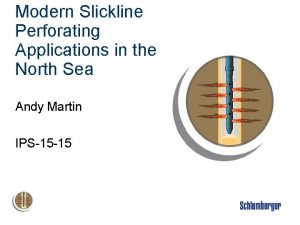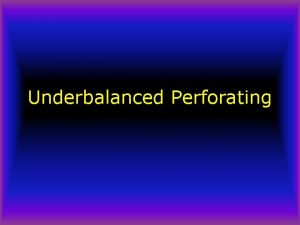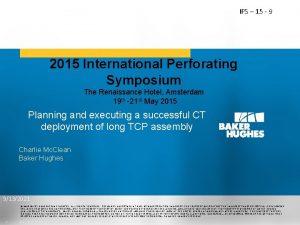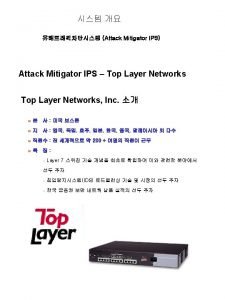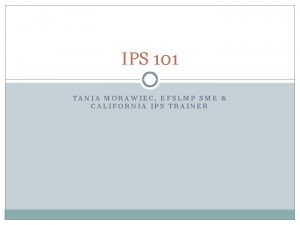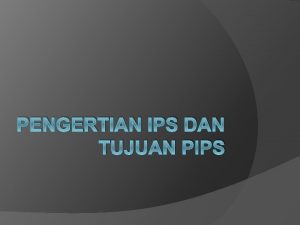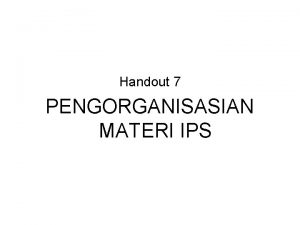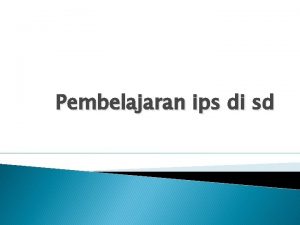IPS 15 21 2015 International Perforating Symposium The






























- Slides: 30

IPS – 15 - 21 2015 International Perforating Symposium The Renaissance Hotel, Amsterdam Tuesday thru Thursday, May 19 -21, 2015 Innovative Flow Through Perforating System © 2014 Baker Hughes Incorporated. All Rights Reserved. Stephen Zuklic, Baker Hughes Stan Hilligiest, Baker Hughes 1 © 201 4 B AK ER HUGH ES I NCORPO RATED. ALL RIGHTS RESERVED. TERMS AND CONDITIONS OF USE: BY ACCEPTING THIS DOCUMENT, THE RECIPIENT AGREES T HAT THE DOCUMENT TOGETHER WITH ALL INFORMATION INCLUDED THEREIN IS T HE CONFI DENTIAL AND PROPRIETARY PROPERTY OF B AK ER HUGHES INCORPORATED AND INCLUDES VALUABLE TRADE SECRETS AND/OR PROPRIETARY INFORMATION OF BAKER HUGHES (CO LLECTIVELY "INF OR MA TI ON"). BAKER H UGHES RETAINS ALL RIGHTS UNDER COPY RIGHT LAWS AND TRADE SECRET LAWS OF THE UNITED STATES OF AMERICA AND OT HER COUNTRIES. THE RECIPIENT FURTHER AGRE ES T HA T THE D OC UM ENT MAY NO T BE DISTRIBUTED, TRANSMITTED, COPIE D OR REPRODUCED IN WHOLE OR IN PART BY ANY MEANS, ELECTRONIC, MECHANICAL, OR OT HERWISE, WITHOUT THE EXPRESS PRIOR WRI TTEN C ONSENT OF B AKER HUG HES, AND MAY NOT BE USED DIRECTLY OR INDIRECTLY IN ANY WAY DETRIMENTAL TO BAKER HUGHES’ INTEREST.

IPS – 15 - 21 Flow Through Perforating System Discussion Topics ▪ ▪ ▪ Categories of perforating methods Benefits and challenges of each method Flow Through Perforating System solution – Case history System function Technical Summary Q&A

IPS – 15 - 21 Standard Tubing Conveyed Perforating (TCP) Methods Shoot and Pull • Extra rig time to pull assembly • Formation damage from fluid loss and LCM’s (reduced productivity) • Increased well control risk • Higher completion fluid costs If rathole isn’t available to accept spent guns, assembly must be pulled prior to running final completion assembly Shoot and Drop* ▪ Requires drilling extra rathole (time and cost) ▪ Not viable in – horizontal wells – long intervals – zones just above pressure transitions – uphole recompletes with tight spacing *Permanent Guns are run below the final completion assembly, and after detonation fall into the rathole to allow production Rathole

IPS – 15 - 21 Variations in Field Conditions versus Lab Conditions Kill Weight Fluids and LCM Challenges • Completion fluid filtration • Wellbore clean-up • Rig mixing capabilities • Pill storage concerns • Pill agitation • High temperature challenges

IPS – 15 - 21 Flow-Through System Benefits ▪ Allows installation of entire completion prior to perforating interval(s) ▪ Eliminates cost and time associated with drilling rathole ▪ Eliminates production impairment from fluid loss and LCM damage ▪ Eliminates cost and risk of live well deployment (and undeployment) ▪ Radically changes completion procedures (and cost) on many long intervals in subsea environments Guns and firing system internals “disappear” to allow unrestricted flow of production without pulling guns

IPS – 15 - 21 FTPS: System Function ▪ FBIV: acts as packer setting device and includes lower end to open a fluid path to gun valve / firing system after FBIV opens (this “arms” the system) ▪ FHV: isolates internal explosive components from wellbore fluid; unlocks with firing pressure and drives firing pins in head; fully opens after detonation ▪ Firing head: contains firing pins, initiators and time delay fuses that initiate detonating cord to guns; arranged concentrically for open ID ▪ Gun system with disappearing charge tube and retention systems. Pre-Detonation Post-Detonation

IPS – 15 - 21 FTPS Upper Assembly Firing Head Valve (FHV) Full Bore Isolation Valve (FBIV) Firing Head / Blank Gun Adapter Firing Head

IPS – 15 - 21 FTPS Function Discussion—Primary Actuation Gun drill for fluid by-pass to primary unlocking mechanism Pins pull back Rupture discs (2 primary, 1 secondary) Locking ring pushed up by fluid, allowing lock ring to release mandrel After FBIV opens, primary pins pull back, allowing fluid to be exposed to rupture discs; once discs burst, fluid goes through gun drills and unlocks gun valve mandrel

IPS – 15 - 21 FTPS Function Discussion—Primary Actuation Wellbore hydrostatic Power spring is compressed Piston area of entire gun valve flapper pushes gun valve mandrel down (power spring pushes mandrel upward but is easily overcome by piston area since below flapper is atmospheric pressue)

IPS – 15 - 21 FTPS Function Discussion—Primary Actuation Gun valve mandrel strikes firing pin ring, driving 2 primary firing pins into the time delay fuses. Each fuse ignites detonating cord into a 3 -to-1 receiver booster. (train also detonates “backwards” —if any of the 3 cords detonates, the other two trains are detonated so no live explosives remain).

IPS – 15 - 21 FTPS Function Discussion—Secondary Actuation Wireline / coiled tubing shifting tool can be used to shift the internal sleeve up. This pulls up the 3 rd (secondary) isolation pin, exposing the rupture disc that blocks the gun drill path all the way through the gun valve, down to the secondary firing pin. Note: the rupture disc can be selected to allow removal of the wireline tools before pressuring up to fire. Secondary pin remains pinned and ready to fire regardless of whether primary ring has been moved.

IPS – 15 - 21 FTPS Function Discussion—Primary Actuation Gun gas and fluid pressure entering guns alleviates the differential against the gun valve flapper, and allows the spring to drive the mandrel back up, opening the flapper and “hiding” it behind the tube to create a smooth through-bore.

FTPS: Firing Head Components IPS – 15 - 21

FTPS: Firing Head Components IPS – 15 - 21

FTPS Gun Components IPS – 15 - 21

FTPS: Charges and Charge Tube IPS – 15 - 21

IPS – 15 - 21 Lab and Ballistics Range Testing

IPS – 15 - 21 Charge Tube Time/Temp Response – Composite Data

Time/Temperature Operational Envelope

Time/Temperature Operational Envelope IPS – 15 - 21

IPS – 15 - 21 Proof of Concept System Validation – October 19, 2012

Qualification Testing – Case History Field demonstration test completed on October 19 th 2012 → 3 loaded 14 ft guns, 2 blank, 5, 300 ft TVD → No debris recovered, all shots fired OK IPS – 15 - 21

IPS – 15 - 21 Controlled Field Test Well Environment • Openhole water injector (carbonate) • 7” casing, 6” openhole • ~2, 500 psi BHP / ~140 F BHT • ~5200’ TVD (vertical) • 8. 5 PPG freshwater completion fluid Perforating System • Shoot and pull application • Retrievable hook-wall packer • Spacer tubing • Multi-cycle initiation valve • Gun valve (fluid barrier) • Redundant hydraulic firing head • Gun system (4 -1/2”) • 28’ blank safety spacer (2 guns) • 42’ loaded guns (5 SPF, 39 grm deep penetrator) • Blow-out bull plug

IPS – 15 - 21 Controlled Field Test Operational Sequence • Ran bit past proposed bottom of assembly depth • Picked up gun assembly • Ran in hole • Set packer at depth • Closed workstring fill-up valve • Performed pressure sequence: • 11 cycles pressuring tubing to 3000 psi (held 1 min and bled off) • Pressured tubing to 2400 psi and observed pressure drop (valve actuation) • Waited 8 minutes (pyrotechnic time delay) and observed surface indication of detonation • Unset packer, pull up hole, monitor (low fluid level well)

IPS – 15 - 21 Controlled Field Test Results ü Loading (and downloading of back-ups) at district location ü Successful transport, handling, and make-up of system ü Proper pressure initiation of valve/firing head assembly ü Ballistic transfer across 5/5 connections ü All shots fired ü Blow-out plug released

IPS – 15 - 21 Path Forward Actions • Procedure updates from field installation • Field trial installations to fully verify dynamic characteristics seen in section IV lab testing • Further field trial installations (and potential adjustments) • Assess and add future sizes and enhanced features

IPS – 15 - 21 FTPS: Initial Candidate Selection ▪ Well conditions – Up to 325 F (time dependent) – 8, 000 psi max hydrostatic – 7” or larger casing – Minimum tubing size 3 -1/2” for secondary firing system ▪ Typical applications – Long perforated interval (excessive rat hole cost) – Proximity to: ▪ Water contact ▪ Transition zone ▪ Drilling challenges (f. Fractured granite contact, tar zones, etc) – Wellbore orientation (greater than 60°deviation) – Requirement for production logging following perforating

FTPS Summary ▪ ▪ IPS – 15 - 21 Allows installation of entire completion prior to perforating interval(s) Eliminates cost and time associated with drilling rathole Eliminates production impairment from fluid loss and LCM damage Eliminates cost and risk of live well deployment (and reverse deployment) ▪ Radically changes completion procedures (and cost) on many long intervals in subsea environments

Acknowledgement IPS – 15 - 21 © 2014 Baker Hughes Incorporated. All Rights Reserved. Baker Hughes would like acknowledge Shell Technology and Mark Brinsden for their contributions during the development of the Flow Through Perforating System. We offer our sincere thanks for their support. 29

IPS – 15 - 21 Questions and Discussion Thank you.
 Chara screenshot
Chara screenshot International perforating symposium
International perforating symposium International perforating symposium
International perforating symposium International perforating symposium
International perforating symposium International perforating symposium
International perforating symposium International perforating symposium
International perforating symposium International police executive symposium
International police executive symposium International symposium on molecular spectroscopy
International symposium on molecular spectroscopy Slickline perforating
Slickline perforating Underbalanced perforating
Underbalanced perforating Superficial epigastric vein drains into
Superficial epigastric vein drains into Popliteal artery pulse
Popliteal artery pulse Các châu lục và đại dương trên thế giới
Các châu lục và đại dương trên thế giới Từ ngữ thể hiện lòng nhân hậu
Từ ngữ thể hiện lòng nhân hậu Diễn thế sinh thái là
Diễn thế sinh thái là Tư thế ngồi viết
Tư thế ngồi viết Ng-html
Ng-html V cc
V cc Phép trừ bù
Phép trừ bù Alleluia hat len nguoi oi
Alleluia hat len nguoi oi Sự nuôi và dạy con của hổ
Sự nuôi và dạy con của hổ đại từ thay thế
đại từ thay thế Vẽ hình chiếu vuông góc của vật thể sau
Vẽ hình chiếu vuông góc của vật thể sau Quá trình desamine hóa có thể tạo ra
Quá trình desamine hóa có thể tạo ra Công thức tiính động năng
Công thức tiính động năng Tỉ lệ cơ thể trẻ em
Tỉ lệ cơ thể trẻ em Thế nào là mạng điện lắp đặt kiểu nổi
Thế nào là mạng điện lắp đặt kiểu nổi Lời thề hippocrates
Lời thề hippocrates Dot
Dot Bổ thể
Bổ thể Vẽ hình chiếu đứng bằng cạnh của vật thể
Vẽ hình chiếu đứng bằng cạnh của vật thể
